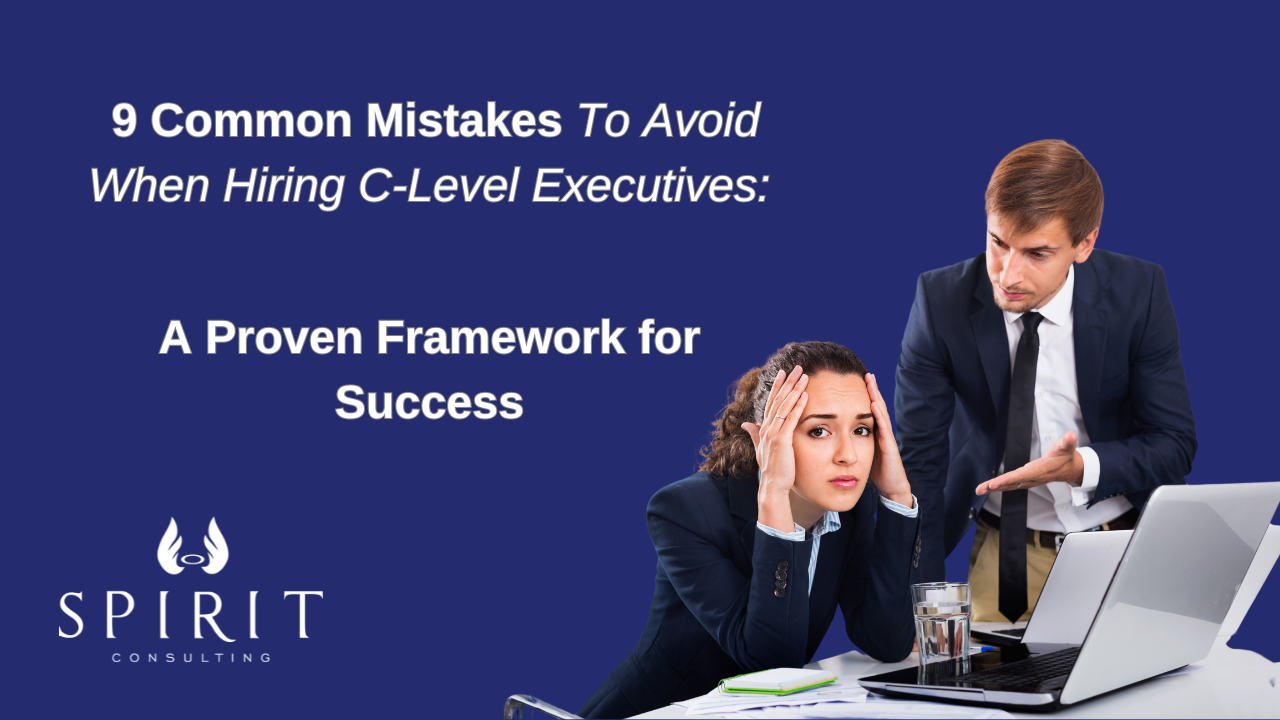In the dynamic landscape of modern business, the role of C-level executives is pivotal in driving innovation, growth, and strategic direction within organizations. However, the process of hiring top-tier leaders comes with its own set of challenges and potential pitfalls. From misaligned expectations to cultural misfits, the mistakes made during the hiring process can have significant repercussions on an organization’s success and trajectory.
Outlined below are nine common mistakes that companies often make when hiring C-level executives, along with how a structured framework comprising three essential steps can help mitigate these risks and ensure the appointment of transformational leaders:
1. Lack of Clarity in Requirements:
Mistake: Failing to define clear and specific requirements for the role can lead to confusion and inefficiency throughout the hiring process.
Solution: Our methodology begins with strategy, including intake meetings and stakeholder analysis, to ensure alignment on the desired qualities and skills of the ideal candidate, as well as a detailed statement of work outlining the responsibilities and expectations for the role.
2. Rushing the Process:
Mistake: Succumbing to pressure to fill the position quickly can result in overlooking qualified candidates or making hasty decisions.
Solution: By following a structured execution plan, which includes thorough recruiting, screening, and presenting of candidates, we ensure that sufficient time and attention are given to each stage of the hiring process, resulting in a comprehensive evaluation and selection of the best-suited candidates.
3. Neglecting Cultural Fit:
Mistake: Focusing solely on qualifications and experience without considering cultural fit can lead to discord within the organization and hinder collaboration and productivity.
Solution: Through client interviews and careful consideration of candidates’ backgrounds and values, our framework emphasizes the importance of assessing cultural fit, ensuring that the selected leader aligns with the organization’s values, vision, and working environment.
4. Overlooking Soft Skills:
Mistake: Prioritizing technical skills over soft skills such as leadership, communication, and emotional intelligence can result in hiring executives who lack the ability to inspire and motivate teams.
Solution: Incorporating scientifically validated assessments and client interviews into the hiring process allows us to evaluate candidates’ soft skills and leadership potential, ensuring that the chosen executive possesses the necessary qualities to drive organizational success.
5. Ignoring Red Flags:
Mistake: Dismissing warning signs or inconsistencies in a candidate’s background or behavior can lead to costly hiring mistakes and disruptions down the line.
Solution: Our framework enables us to identify and address any red flags early in the process through thorough screening, including background checks and reference verification, mitigating the risk of hiring unsuitable candidates.
6. Lack of Stakeholder Involvement:
Mistake: Excluding key stakeholders from the hiring process can result in misalignment and resistance to the chosen candidate, undermining their effectiveness and integration within the organization.
Solution: Our methodology emphasizes stakeholder analysis and involvement from the outset, ensuring that the perspectives and requirements of all relevant parties are considered and incorporated into the decision-making process.
7. Failure to Assess Long-Term Potential:
Mistake: Focusing solely on short-term needs and immediate skill sets can lead to overlooking candidates with the potential to grow and evolve within the organization.
Solution: By conducting comprehensive I/O assessments and evaluating candidates’ long-term potential and adaptability, our framework enables us to identify leaders who not only meet current needs but also have the capacity to drive sustained success and innovation in the future.
8. Inadequate Onboarding and Integration:
Mistake: Neglecting to provide sufficient support and guidance during the onboarding process can result in new executives feeling overwhelmed or disconnected, hampering their ability to perform effectively.
Solution: Our methodology extends beyond the hiring stage to include onboarding and integration support, ensuring that newly appointed leaders receive the necessary resources and assistance to seamlessly transition into their roles and align with the organization’s goals and culture.
9. Lack of Post-Hire Evaluation:
Mistake: Failing to conduct post-hire evaluations or reviews can hinder accountability and prevent organizations from learning from hiring successes and failures.
Solution: Our framework incorporates ongoing evaluation and feedback mechanisms, allowing organizations to assess the performance and impact of newly appointed executives and refine their hiring strategies accordingly, fostering continuous improvement and growth.
Hiring C-level executives requires a strategic and meticulous approach to ensure the selection of transformational leaders who can drive organizational success and growth. By avoiding these common mistakes and following a structured methodology that emphasizes strategy, execution, and closure, organizations can increase their likelihood of appointing executives who not only meet current needs but also have the vision and capability to lead the organization into the future.



0 Comments